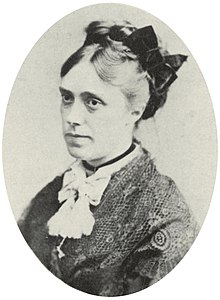Camille Doncieux
Camille-Léonie Doncieux , also Camille Monet , (born January 15, 1847 in La Guillotière (now Lyon ); died September 5, 1879 in Vétheuil ) was a French model . She first became the mistress and in 1870 the first wife of the painter Claude Monet . He portrayed her in at least 58 paintings; no person appears more often in his pictures. In addition, Pierre-Auguste Renoir and Édouard Manet showed them in their paintings.
Life
Little is known about the life of Camille Doncieux. Besides the official documents, there are hardly any written testimonies from or about her. Her correspondence with Claude Monet has survived, as have letters to Camille Doncieux from family members or friends. These documents and family photos with Camille Doncieux were destroyed by Claude Monet, possibly at the instigation of Alice Hoschedé , Monet's second wife. Daniel Wildenstein , Monet's biographer and the author of his catalog raisonné, assumes this . However, he had no supporting documents to support this assumption. On the other hand, letters from Claude Monet to his friends in which he speaks of Camille Doncieux and a photograph of her that were taken by Albert Greiner in Amsterdam in 1871 have survived . In addition, numerous paintings by Monet to this day bear witness to his first wife, some of which he kept until the end of his life.
Camille-Léonie Doncieux was born in La Guillotière, a suburb of Lyon since 1852, in 1847. Her father was Charles-Claude Doncieux, her mother Léonie Françoise, née Manéchalle. The father's occupation is sometimes given as a businessman, sometimes as an employee. The family moved to rue Neuve-des-Poirées (now rue Toullier) in the 5th arrondissement in Paris during their childhood . Her sister Geneviève-Françoise was born there in 1857. After 1860 the family moved to Rue Truffaut in the Batignolles quarter of the 17th arrondissement .
Around the age of 18, Camille Doncieux began working as a model for various painters. When and how she met Monet is not known. His former studio on Place Pigalle was not far from her parents' apartment. The two must have met for the first time before February / March 1865, as Monet began work on his painting Breakfast in the Green , for which she was the model. In the middle fragment of the version of the Musée d'Orsay in Paris she is the central figure, in the preparatory version The Walkers ( National Gallery of Art , Washington DC) she can be seen at the side of Monet's painter friend Frédéric Bazille . Instead of the incomplete group picture, Monet sent the portrait of Camille in a green dress ( Kunsthalle Bremen ) to the exhibition at the Salon de Paris in 1866 , where it received good reviews. After this success, Camille Doncieux was again a model for Monet in Ville-d'Avray , who presumably took her as a model for all four women depicted in the multi-figure painting Women in the Garden (Musée d'Orsay). The art historian John Rewald wrote of Claude Monet's encounter with Camille Doncieux that she was a girl in 1866 that he "had met recently and that he would soon share his misery, hopes and disappointments". With this remark, Rewald described the difficult living conditions of Monet, who in the following years fought for his recognition as a painter and whose economic circumstances were extremely difficult.
In the summer of 1866, Camille Doncieux and Claude Monet traveled to Normandy ; Since this time at the latest, a relationship between them can be assumed. While both lived in Saint-Siméon , Monet visited his family alone in Sainte-Adresse . After the death of his mother, who died in 1857, he received financial support from his aunt Marie-Jeanne Lecadre. He feared that his aunt might stop providing support if the relationship with Camille Doncieux became known. He was more open to his friends and met his fellow painters Gustave Courbet and Eugène Boudin at the side of Camille Doncieux in the seaside resort of Deauville .
In addition to the cash payments from his aunt, Monet occasionally received financial help from his friends, as he hardly made any income from selling paintings. In the 1860s it was mainly Frédéric Bazille who supported Monet. These donations became more and more necessary as Camille Doncieux was meanwhile expecting a child. In April 1867, Monet informed his father Claude-Adolphe Monet of the impending birth, who reacted negatively. On August 8, 1867, Camille Doncieux gave birth to their son Jean-Armand-Claude - called Jean - in Paris. Monet's friend Frédéric Bazille became the godfather. At that time Monet was mostly with his father and aunt in Le Havre . However, he must have been to short visits to Paris, where he portrayed the newborn in Jean Monet in his cradle (National Gallery of Art, Washington DC) and Jean Monet asleep ( Ny Carlsberg Glyptotek , Copenhagen).
Even after the child was born, Monet's father refused to support the young family. Instead, he advised Claude Monet to part with Camille Doncieux. In the winter of 1866/1867 Monet returned to Paris, where the family lacked the most essential things. There was no money to buy coal, and there was not enough food for the young mother with the child. Financial pressures forced the family to move frequently. Rents were cheaper in rural areas, but they mostly had to leave their homes because of rent debts. In 1868 Camille Doncieux moved to Bennecourt with their son Jean and Monet , in August they took a room in Fécamp , went to Étretat at the end of October 1868 and stayed there until spring 1869. They then moved to Saint-Michel near Bougival . Monet's aunt continued to refuse payments. She offered Monet to live with her for free if he ended his relationship with Camille Doncieux.
Against the advice of his family, Claude Monet and Camille Doncieux married on June 28, 1870. One of the best man was the painter Gustave Courbet . The couple concluded a marriage contract in which the separation of property was agreed. She received a donation of 12,000 francs from her parents, which was due after her father's death. She was entitled to the annual interest from this sum in advance. A little later, on July 7th, Monet's aunt Lecadre died. Claude and Camille Monet spent the summer of 1870 with their son Jean in Trouville on the Normandy coast. There were various beach views, some of which were modeled on Camille. After France declared war on Prussia on July 19, Claude Monet went to London in the autumn of 1870. A little later, Camille Monet and her son Jean followed. In London, Monet painted his wife in the interior painting Meditation, Madame Monet on the sofa (Musée d'Orsay). Monet's father died on January 17, 1871 while he was still in London. Claude Monet stayed with his family in England until the end of May 1871 because of the uncertain political situation during the Paris Commune . Then they traveled to the Netherlands, where they stayed in a hotel in Zaandam . Camille Monet contributed to the family income with French lessons. Because of the continued uneasy political situation in France, the Monets did not return to Paris until November 1871.
In December 1871, Monet rented a house in Argenteuil , where the family lived until the end of 1874. After Claude Monet received his paternal inheritance in 1872 and was able to sell some paintings to the art dealer Paul Durand-Ruel , the Monet family temporarily found themselves in financial relief. Accordingly, they afforded a housemaid and a nanny. In Argenteuil, the Monets received a visit from the painter Pierre-Auguste Renoir in the summer of 1873 , who, among other pictures, also created four portraits of Camille Monet on site. Camille's father died on September 22, 1873 and part of the inheritance was paid out to her. In the summer of 1874, the painter Édouard Manet came to visit and portrayed Camille and Claude Monet on his studio boat. In addition, like Renoir, who was also present, he painted portraits of the Monet family in the garden of Argenteuil. Although Claude Monet had sold paintings, for example to the cloth wholesaler Ernest Hoschedé and the opera singer Jean-Baptiste Faure , financial problems returned and he asked Manet for money. Despite these financial worries, the family moved to a larger house in Argenteuil that autumn. The following year, Camille had to pledge 2,000 francs from her inheritance to the paint dealer Carpentier in order to pay her husband's bills.
At a sales exhibition at the Hôtel Drouot in 1876, Monet bought the portrait of Camille in Japanese costume ( Museum of Fine Arts, Boston ) from the previous year for 2,020. Sell Franc. In this exotic painting, the sitter not only wears a Japanese kimono but also a blonde wig. Despite these positive proceeds, the Monets' financial situation was again very tense. Once again friends helped out, such as the painter Gustave Caillebotte and Manet's brother Eugène . In July 1876, Claude Monet visited Rottembourg Castle in Montgeron , where he was supposed to paint various pictures for the Hoschedé family. He stayed intermittently until December of that year. While Camille Monet lived in Argenteuil and Ernest Hoschedé was mostly in Paris, a love affair may develop between Claude Monet and Alice Hoschedé, the entrepreneur's wife. However, there is no evidence of this.
Since the summer of 1877, Camille Monet was pregnant again. There were also money problems, which Claude Monet tried to alleviate with letters of petition to the writer Emile Zola and the doctor Georges de Bellio . Claude Monet spoke to the doctor de Bellio for the first time about his wife's illness. In early 1878 the Monet family moved to Paris at 26 rue d'Edimbourg. Their son Michel Monet was born there on March 17th .
In September 1878 Claude Monet moved to Vétheuil ; his wife and two sons followed shortly afterwards. In October of that year, the Monets and the Hoschedé family moved into a larger house on the road to La Roche-Guyon . Ernest Hoschedé had previously become insolvent and had to give up the apartments in Paris and Montgeron. The Hoschedé family had six children, so that a total of twelve people lived in the household with the Monet family. While Ernest Hoschedé stayed mostly in Paris, Alice Hoschedé gave piano lessons and took over the household and the upbringing of the children of the Monet-Hoschedé families. Camille Monet, who suffered from abdominal cancer, worsened in 1879. Alice Hoschedé took care of her, who wrote in a letter: “It is dreadful to see such torments, and in this respect one can only wish for death.” August 1879, as they had previously only been married in a civil ceremony. At the same time she received the sacraments of death . She died on September 5, 1879 at the age of 32 in Vethéuil and was buried two days later in the local cemetery. Monet painted the commemorative picture of Camille Monet on his deathbed of his late wife (Musée d'Orsay, Paris). It was not until several years after the death of Ernest Hoschedé in 1892 that Claude Monet and Alice Hoschedé married.
Camille Doncieux in Monet's paintings
Camille Doncieux was available as a model for Claude Monet from 1865 to 1879. She can be seen in at least 58 surviving paintings; no other person was painted more often by Monet. He created portraits, group portraits, genre scenes, interiors and, in the 1870s, mainly landscape pictures, in which she mostly appears as a staffage figure. This includes, for example, the painting Gladiolus from 1876 ( Detroit Institute of Arts ). Monet painted only a few portraits of her in the narrower sense. These include the painting Camille with her little dog from 1866 (private collection) and the portrait of Camille with a bouquet of violets from 1877 (private collection), in which he shows her as a living person for the last time. The final point is the unusual painting Camille Monet on the death bed from 1879 (Musée d'Orsay, Pars). Other works are only superficially a portrait of Camille Doncieux. In Camille in a green dress from 1866 ( Kunsthalle Bremen ) , Monet also presents the type of Parisian from the 1860s, while in the picture Camille Monet with a child in the garden from 1875 ( Museum of Fine Arts, Boston ) she is seen in the role of mother . In the painting Madame Monet with a red hood from 1868–1869 ( Cleveland Museum of Art ) he “used Camille in a series of pictorial experiments that have to do with the reproduction of movement, space and lighting as well as the representation of the woman herself. "
| image | Title (year of creation) | Catalog raisonné no. | collection |
|---|---|---|---|

|
The Walkers (Bazille and Camille) (1865) |
W 61 | National Gallery of Art , Washington, DC |

|
Breakfast in the Green (1865) |
W 62 | Pushkin Museum , Moscow |

|
Breakfast in the Green (Fragment I) (1865) |
W 63/1 | Musée d'Orsay , Paris |

|
Breakfast in the Green (Fragment II) (1865) |
W 63/2 | Musée d'Orsay , Paris |
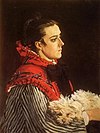
|
Camille with her little dog (1866) |
W 64 | Privately owned |

|
Camille or Camille in a Green Dress (1866) |
W 65 | Kunsthalle Bremen , Bremen |

|
Camille or Camille in a Green Dress (1866) |
W 66 | Muzeul Național de Artă al României , Bucharest |
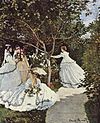
|
Women in the Garden (1866) |
W 67 | Musée d'Orsay , Paris |

|
On the bank at Bennecourt (1868) |
W 110 | Art Institute of Chicago , Chicago |

|
The Dinner (1868–1869) |
W 129 | EG Bührle Collection Foundation , Zurich |

|
The Room After Dinner (1868–1869) |
W 130 | National Gallery of Art , Washington, DC |

|
The Breakfast (1868–1869) |
W 132 | Städel Museum , Frankfurt am Main |

|
The Landsteg (1869) |
W 138 | Privately owned |

|
The beach at Trouville (1870) |
W 158 | National Gallery , London |

|
Camille seated on Trouville beach (1870) |
W 159 | Privately owned |

|
Camille on the Beach at Trouville (1870) |
W 160 | Yale University Art Gallery , New Haven (Connecticut) |
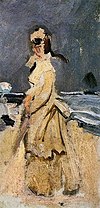
|
Camille on the Beach (1870) |
W 161 | Marmottan Monet Museum , Paris |

|
On the beach at Trouville (1870) |
W 162 | Marmottan Monet Museum , Paris |

|
Meditation, Madame Monet on the sofa (1871) |
W 163 | Musée d'Orsay , Paris |

|
The garden (1872) |
W 202 | Privately owned |

|
Lilac bushes in cloudy weather (1872) |
W 203 | Musée d'Orsay , Paris |

|
Lilac bushes in the sunshine (1872) |
W 204 | Pushkin Museum , Moscow |

|
The Reading (1872) |
W 205 | Walters Art Museum , Baltimore |

|
Madame Monet with a red hood (1868–1869) |
W 257 | Cleveland Museum of Art , Cleveland |

|
Madame Monet in a Garden (1872) |
W does not exist | Privately owned |

|
Poppy field near Argenteuil (1873) |
W 274 | Musée d'Orsay , Paris |

|
Walk in the meadows at Argenteuil (1873) |
W 276 | Privately owned |

|
Camille with Jean and nanny in the garden (1873) |
W 280 | Privately owned |

|
On the bench (1873) |
W 281 | Metropolitan Museum of Art , New York |

|
Camille and Jean Monet in the Garden of Argenteuil (1873) |
W 282 | Privately owned |

|
The Artist's House at Argenteuil (1873) |
W 284 | Art Institute of Chicago , Chicago |

|
The Lunch (1873) |
W 285 | Musée d'Orsay , Paris |
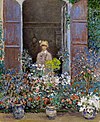
|
Camille Monet at the Window (1873) |
W 287 | Virginia Museum of Fine Arts , Richmond, Virginia |

|
View of the Argenteuil Bridge (1874) |
W 321 | Saint Louis Art Museum , Saint Louis |

|
Meadow in Bezons (summer) (1874) |
W 341 | National Gallery , Berlin |

|
In the artist's house (1875) |
W 365 | Musée d'Orsay , Paris |

|
Camille embroidering (1875) |
W 366 | Barnes Foundation , Philadelphia |

|
Camille Monet with Child in the Garden (1875) |
W 382 | Museum of Fine Arts , Boston |
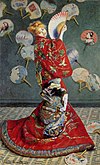
|
Camille in Japanese Costume (1875) |
W 387 | Museum of Fine Arts , Boston |

|
In the meadow (1876) |
W 405 | Privately owned |

|
Woman in the Garden (1876) |
W 407 | Hermitage , Saint Petersburg |
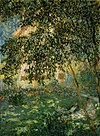
|
Rest in the garden of Argenteuil (1876) |
W 408 | Privately owned |

|
Camille in the garden of the house at Argenteuil (1876) |
W 410 | Metropolitan Museum of Art , New York |

|
The garden (1876) |
W 411 |
Kunsthalle Bremen (lost in the war), currently Hermitage , Saint Petersburg |

|
Garden with hollyhocks (1876) |
W 412 | Privately owned |

|
Camille with the Green Parasol (1876) |
W 413 | Privately owned |

|
Gladiolus (1876) |
W 414 | Detroit Institute of Arts , Detroit |

|
In the garden, gladioli (1876) |
W 415 | San Francisco Museum of Modern Art , San Francisco |

|
Portrait of Camille with a bouquet of violets (1877) |
W 436 | Privately owned |
literature
- Ruth Butler: Hidden in the shadow of the master, the model-wives of Cézanne, Monet, and Rodin. Yale University Press, New Haven 2008, ISBN 978-0-300-12624-2 .
- Mary Mathews Gedo: Monet and His Muse: Camille Monet in the Artist's Life. University of Chicago Press, Chicago 2010, ISBN 978-0-226-28480-4 .
- Dorothee Hansen (ed.), Wulf Herzogenrath (ed.): Monet and Camille - portraits of women in impressionism. Hirmer-Verlag, Munich 2005, ISBN 3-7774-2705-5 .
- Jill Berk Jiminez: Dictionary of artists' models. Fitzroy Dearborn, London 2001, ISBN 1-57958-233-8 .
- Daniel Wildenstein : Claude Monet, biography et catalog raisonné. Bibliothèque des arts, Lausanne 1974–1991.
- John Rewald : The History of Impressionism: Fate and Work of the Painters of a Great Epoch of Art. DuMont, Cologne 2001, ISBN 978-3-7701-5561-3 .
- Sidsel Maria Søndergaard: Women in impressionism, from mythical feminine to modern woman. Skira, Milan 2006, ISBN 87-7452-283-3 .
Web links
Individual evidence
- ↑ Birth and death dates according to Jill Berk Jiminez: Dictionary of artists' models , p. 165.
- ^ Daniel Wildenstein: Claude Monet, biography et catalog raisonné , Vol. I, p. 99.
- ↑ Dorothee Hansen: Monet and Camille - Biography of a Relationship in Dorothee Hansen, Wulf Herzogenrath: Monet and Camille - Women Portraits in Impressionism , p. 22.
- ↑ Ruth Butler: Hidden in the shadow of the master, the model-wives of Cézanne, Monet, and Rodin , p. 96.
- ↑ a b c d Dorothee Hansen: Monet and Camille - Biography of a relationship. In: Dorothee Hansen, Wulf Herzogenrath: Monet and Camille - Portraits of Women in Impressionism , p. 24.
- ↑ Ruth Butler: Hidden in the shadow of the master, the model-wives of Cézanne, Monet, and Rodin , p. 96.
- ^ A b c Jill Berk Jiminez: Dictionary of artists' models , p. 165.
- ^ Mary Mathews Gedo: Monet and His Muse: Camille Monet in the Artist's Life , p. 20.
- ↑ John Rewald: The History of Impressionism: Fate and Work of the Painters of a Great Epoch of Art , p. 95.
- ↑ a b c Dorothee Hansen: Monet and Camille - Biography of a relationship. In: Dorothee Hansen, Wulf Herzogenrath: Monet and Camille - Portraits of Women in Impressionism , p. 25.
- ^ Dorothee Hansen: Monet and Camille - Biography of a relationship. In: Dorothee Hansen, Wulf Herzogenrath: Monet and Camille - Portraits of Women in Impressionism , p. 27.
- ↑ John Rewald: The History of Impressionism: Fate and Work of the Painters of a Great Epoch of Art , p. 112.
- ↑ John Rewald: The History of Impressionism: Fate and Work of the Painters of a Great Epoch of Art , p. 121.
- ^ Dorothee Hansen: Monet and Camille - Biography of a relationship. In: Dorothee Hansen, Wulf Herzogenrath: Monet and Camille - Portraits of Women in Impressionism , pp. 28–30.
- ^ Dorothee Hansen: Monet and Camille - Biography of a relationship. In: Dorothee Hansen, Wulf Herzogenrath: Monet and Camille - Portraits of Women in Impressionism , p. 30.
- ↑ a b c d e f g h Dorothee Hansen: Monet and Camille - Biography of a relationship. In: Dorothee Hansen, Wulf Herzogenrath: Monet and Camille - Portraits of Women in Impressionism , p. 31.
- ^ Mary Mathews Gedo: Monet and His Muse: Camille Monet in the Artist's Life , p. 115.
- ^ Dorothee Hansen: Monet and Camille - Biography of a relationship. In: Dorothee Hansen, Wulf Herzogenrath: Monet and Camille - Portraits of Women in Impressionism , p. 32.
- ↑ Camille Monet received 6,000 francs as an immediate payment, another 2,000 francs was to be paid by the mother later. The initially planned total of 12,000 francs were not available as assets. See Dorothee Hansen: Monet and Camille - Biography of a Relationship. In: Dorothee Hansen, Wulf Herzogenrath: Monet and Camille - Portraits of Women in Impressionism , p. 32.
- ^ A b Dorothee Hansen: Monet and Camille - Biography of a relationship. In: Dorothee Hansen, Wulf Herzogenrath: Monet and Camille - Portraits of Women in Impressionism , p. 33.
- ↑ a b c Dorothee Hansen: Monet and Camille - Biography of a relationship. In: Dorothee Hansen, Wulf Herzogenrath: Monet and Camille - Portraits of Women in Impressionism , p. 34.
- ^ Dorothee Hansen: Monet and Camille - Biography of a relationship. In: Dorothee Hansen, Wulf Herzogenrath: Monet and Camille - Portraits of Women in Impressionism , pp. 34–35.
- ↑ a b c Dorothee Hansen: Monet and Camille - Biography of a relationship. In: Dorothee Hansen, Wulf Herzogenrath: Monet and Camille - Portraits of Women in Impressionism , p. 35.
- ^ Dorothee Hansen: Monet and Camille - Biography of a relationship. In: Dorothee Hansen, Wulf Herzogenrath: Monet and Camille - Portraits of Women in Impressionism , p. 37.
- ^ Letter from Alice Hoschedé to her mother dated August 26, 1879. Quoted from Dorothee Hansen: Monet and Camille - Biography of a relationship. In: Dorothee Hansen, Wulf Herzogenrath: Monet and Camille - Portraits of Women in Impressionism , p. 38.
- ^ Dorothee Hansen: Monet and Camille - Biography of a relationship. In: Dorothee Hansen, Wulf Herzogenrath: Monet and Camille - Portraits of Women in Impressionism , p. 38.
- ↑ Sidsel Maria Søndergaard, Tea Baark Mairey: Like a Quivering between Things in Sidsel Maria Søndergaard: Women in impressionism, from mythical feminine to modern woman , p. 233.
- ↑ Dorothee Hansen speaks to Camille with her little dog and portrait of Camille with the bouquet of violets from two classic portraits. See Dorothee Hansen: Monet and Camille - Biography of a Relationship in Dorothee Hansen, Wulf Herzogenrath: Monet and Camille - Women Portraits in Impressionism , p. 41.
- ↑ Dorothee Hansen: Monet and Camille - Biography of a Relationship in Dorothee Hansen, Wulf Herzogenrath: Monet and Camille - Women Portraits in Impressionism , p. 97.
- ↑ Ruth E. Iskin: What There a New Woman in Impressionist Painting? in Sidsel Maria Søndergaard, Tea Baark Mairey: Like a Quivering between Things in Sidsel Maria Søndergaard: Women in impressionism, from mythical feminine to modern woman , p. 206.
- ↑ Analogous German translation. In the original: "In this way, Monet made use of Camille in an number of pictorial experiments, which have just as much to do with the rendering of movement, space and lighting conditions as they do with the portrayal of the woman herself." Sidsel Maria Søndergaard, Tea Baark Mairey: Like a Quivering between Things in Sidsel Maria Søndergaard: Women in impressionism, from mythical feminine to modern woman , p. 233.
| personal data | |
|---|---|
| SURNAME | Doncieux, Camille |
| ALTERNATIVE NAMES | Doncieux, Camille-Léonie; Monet, Camille |
| BRIEF DESCRIPTION | Claude Monet's first wife and model |
| DATE OF BIRTH | January 15, 1847 |
| PLACE OF BIRTH | La Guillotiere (now Lyon ) |
| DATE OF DEATH | September 5, 1879 |
| Place of death | Vétheuil |
